| (Note: The Eastern
end of High Street used to be called Bridge Street) |
|
Click on a picture for a more detailed
image.
|
|
|
|
You are here |
|
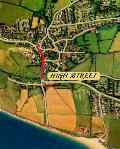 |
|
|
|
|
A very early view of the Anchor Inn, pre-telegraph
poles.
Cattle herds have left their mark! C. 1905 |
|
 |
|
|
|
|
Motoring' in style (C. 1915), clearly
'an event' as
witnessed by the distant bevy of spectators. |
|
 |
|
|
|
|
A solid-tyred lorry carts off the church
bells for re-casting,
maybe at Yeovil. Note the Anchor 'Inn' is now an 'hotel'! |
|
 |
|
|
|
|
A rough High Street leads towards Charlie
More's Fish Yard
behind the gate and opposite the village 'Lock-up' (now 'Jaynes')
C. 1915 |
|
 |
|
|
|
| A view along High Street. Anchor far left
and the 'Lock-up' behind right. |
|
 |
|
|
|
| The Pound |
|
 |
|
|
|
| The Anchor Hotel |
|
 |
|
|
|
|
| The Anchor Hotel |
|
 |
|
|
|
|
Very early view (C. 1900) of the High
Street.
The two ladies braid nets at their open doors in Donkey Lane. |
|
 |
|
|
|
|
A busy day on a muddy High Street before
telephones and traffic restrictions. C. 1905 |
|
 |
|
|
|
|
| Old view looking east |
|
 |
|
|
|
|
Mill Street joins High Street at 'Carner' - the low wall
where fish were displayed daily for sale. Note the
Post Office building, now part of the 'Horseshoes'. |
|
 |
|
|
|
|
| Post Office corner with the old 'phone
box |
|
|
|
|
|
|
| Old Post Office at Mill Street/High
Street corner |
|
 |
| |
|
|
| Old Post Office at Mill Street/High
Street corner C. 1915 |
|
 |
|
|
|
| Old Post Office at Mill Street/High
Street corner C. 1902 |
|
 |
|
|
|
| Note the modern metal 'casements'
in the cottages left. |
|
 |
|
|
|
| Cynthia Steven from Southover
holding small child |
|
 |
|
|
|
| Bridge Stores with a "Special
Offer" C. 1915. |
|
 |
|
|
|
| Looking east |
|
 |
|
|
|
| Post Office with a 'new fangled'
telephone C. 1930 |
|
 |
|
|
|
Manor Farm 'chestnuts' dominate
middle of High Street,
also a very good view of the cottages next to
Bridge Stores which were later burnt down. |
|
 |
|
|
|
| Photograph of a painting of
the High Street |
|
 |
|
|
|
Haywards (now Bridge Stores)
in C. 1920. A wonderful e
mporium supplying all the average villager needed,
from mothballs to soap, and from lamp oil to tea.
The front of the shop was washed away during the floods of 1916. |
|
 |
|
|
|
| High Street below Anchor Hotel.
C. 1920. |
|
 |
|
|
|
| High Street East |
|
 |
|
|
|
Views such as this (C. 1959)
were common until quite recently.
There were several herds which made their way
twice daily to their milking sheds;
careful timing was clearly necessary. |
|
 |
|
|
|
Access to water was vital;
here, old steps lead down to a
stream close to Bridge Stores. This water is
from the spinning mill race. |
|
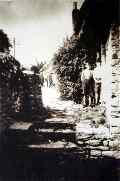 |
|
|
|
Early view of High Street with
the cottage
on the right that later burnt down. |
|
 |
|
|
|
Manor Farm garden
Click on picture for funny story in 'Darst Lingo' |
|
 |
|
|
|
| Milk from Manor Farm being
transferred by Fred Kerley. |
|
 |
|
|
|
Milk being collected from Manor
Farm,
probably by Mr Rowe of Bredy Farm C. 1935 |
|
 |
|
|
|
| Manor Farm as it was. |
|
 |
|
|
|
An early photograph (C. 1897)
looking westward
along Bridge High Street. The Symes' cottage,
now known as 'Longbarn', is first on the right. |
|
 |
|
|
|
Duke" Symes' cottage (on
the right) overlooks the River Bride,
which at that time was subject to severe flooding.
A footpath led from the end of the railings on
the left side of the bridge, southwards to the flax
sheds of Freshwater. Duke, so called owing
to his high opinion of himself, was the village carrier. |
|
 |
|
|
|
| Symes' cottage C. 1912 |
|
 |
|
|
|
| High Street East |
|
 |
|
|
|
| Note grocer's shop on right,
now a cottage called 'Longbarn'. |
|
 |
|
|
|
This was printed onto carrier
bags from Mullins' shop -
now Bridge Stores. |
|
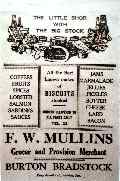 |
|
|
|
Looking up High Street.
Note cottage next to the shop has burnt down. |
|
 |
|
|
|
| High Street East |
|
 |
|
|
|
A view looking east towards
Cliff Road.
The slated roof of the smithy is clearly visible
beyond the bridge railings on the right.
Note the hoarding advertising the News Chronicle. |
|
 |
|
|
|
| Early view, before the cottage
was converted into a shop. |
|
 |
|
|
|
| Prams, bicycles and a horse
and cart in Bridge Street C. 1920 |
|
 |
|
|
|
Cars and vans add to the bustling
scene around 1960.
The shop appears prosperous, but the building
suffers from damp as shown on the wall,
a common problem in old cottages. |
|
 |
|
|
|
A mystery tower below the church
adjoins
Mill Terrace: it is probably the steam engine house. |
|
 |
|
|
|
Benny Burton, blacksmith, at
work on a
hoof at his smithy in Bridge Street. |
|
 |
|
|
|
| Dennis Burton hard at work
in the Smithie |
|
 |
|
|
|
The Smithy in the good old
days.
The building is now derelict and in danger of collapse. |
|
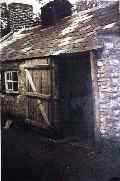 |
|
|
|
Another vital job being carried
out by Steve Northover
recutting a millstone. The upright wooden pan,
when in place, received the ground flour. |
|
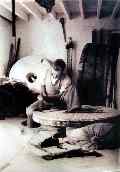 |
|
|
|
Picture is taken from a photograph
of the original
watercolour by Helen Allingham, at the turn
of the Century, a well known water colourist.
The original was sold at Christies or Sotheby's in 1981 for £3,000.
|
|
 |
|
|
|
Photograph of a later painting
of ladies outside Long Barn -
by Helen Allingham |
|
 |
|
|
|
| Anchor Hotel as you might see
it today |
|
 |
|
|
|
| Bridge Stores and High Street
as you might see them today |
|
 |
|
|
|
| High Street as you might see
it today |
|
 |
|
|
|
| Symes' cottage as you might
see it today |
|
 |